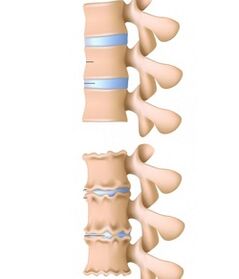
What causes cervical osteochondrosis? What are the symptoms? How to effectively treat cervical spine osteochondrosis at home?
Cervical osteochondrosis is one of the most widespread diseases that is increasingly affecting young people (aged 25 - 40 years). The development of cervical osteochondrosis is facilitated by prolonged in a state of incorrect and tense posture - for example, working at a computer during the day or the habit of supporting the receiver of the phone with your shoulders.
Often caused by prolonged vibration exposure, such as when working with construction equipment or driving a car. Also, improper posture, uncomfortable bedding, inactive lifestyle, hereditary predisposition and other factors can cause cervical osteochondrosis.
Cervical osteochondrosis and its causes
Cervical osteochondrosis is a degenerative-dystrophic lesion of the intervertebral disc in the cervical spine. It occurs against the background of metabolic disorders of the cervical spine, in which the structure of the intervertebral disc (a special spacer between the vertebrae) and the vertebral body itself changes.
In terms of symptoms, cervical osteochondrosis is quite different from osteochondrosis of other parts. This is the most dangerous type of osteochondrosis, as it often causes violation of nerve roots extending from the spinal cord and disruption of blood supply to the brain due to compression of blood vessels. The reason is the peculiarity of the anatomical structure of the spine in the cervical zone. Thus, one of the large arteries that feed the brain - the vertebrae - passes right at the opening of the cervical vertebrae process. Thus, pathological changes in it - the proliferation of bone and fibrous tissue, displacement of the vertebrae - cause disruption of the normal function of these arteries.
In addition, the structure of the spine in the cervical spine is quite different - the vertebrae are close to each other. Thus, with pathological changes in one of the vertebrae, although insignificant, the normal function of the whole part is disrupted - depression or shifting of nerves and blood vessels, as well as more frequent compression of the spinal cord than in lumbar or thoracic osteochondrosis. As a result, with cervical osteochondrosis, significant dysfunction can be observed - disorders of sensitivity of the skin and muscles of the neck, face, hands, dizziness attacks. There may be noise or ringing in the ears and head, persistent headaches, increased fatigue, blurred vision and hearing, instability when walking, and so on.
Symptoms of cervical osteochondrosis

Of the symptoms of cervical osteochondrosis, we note the following:
- Pain in the neck, back of the head, shoulders or arms. In addition, weakness of the arm muscles, difficulty with the movement of the head, cracks in the neck when turning or tilting the head to the side are often observed.
- Often there is pain on the left side of the chest, which radiates to the left arm. There may be a burning or pain sensation between the shoulder blades.
- Cervical osteochondrosis causes recurrent headaches, a feeling of weakness and increased fatigue. As a rule, the pain is excruciating and concentrated on the sides and back of the neck, as well as on the back of the head. Patients often have difficulty moving the head, especially when turning in different directions.
- Neck pain can radiate to the arms and extend from the shoulders to the hands with numbness in the fingers. In these cases, sometimes patients complain of "itching" or "passage of electric current" along the arms and legs when bending the neck.
- Cervical osteochondrosis can also cause hearing and vision impairment, pain in the hands, impaired heart and lung function, dizziness, nausea, double vision, numbness of the face and tongue.
What is cervical osteochondrosis? What are the symptoms? How to treat cervical osteochondrosis?
Treatment of cervical osteochondrosis
As a rule, cervical osteochondrosis begins in a mild form and does not pose any particular difficulty in the person at first. Medical treatment at this stage is usually not necessary, only to prevent further complications, improve working conditions, and improve a better lifestyle.
To prevent cervical osteochondrosis, you should lead an active lifestyle, do morning exercises, follow a moderate calorie diet, get rid of bad habits and avoid weight gain. Proper posture, proper posture while sitting and sleeping, comfortable bed is also an important factor in its prevention. Rehabilitation gymnastics courses will also come in handy.
However, as we age, cervical osteochondrosis develops and can progress to more serious forms. In this case, treatment of cervical osteochondrosis is carried out by conservative methods. Among them: wearing a special collar, physiotherapy, exercise therapy, massage. In more severe cases, patients may need drug therapy - analgesics, antispasmodics, nonsteroidal anti -inflammatory drugs (NSAIDs). Physiotherapeutic procedures are also prescribed (paraffin, medical electrophoresis, etc. ).
For the treatment of chronic osteochondrosis of the cervical spine, chondroprotectors are indicated, as well as B vitamins (B6, B12). Drugs for external use are widely used - ointments, creams, gels containing NSAIDs, local irritants and tissue regeneration stimulants.
Recently, new drugs have appeared in pharmacies that can provide serious assistance in the treatment of cervical osteochondrosis-therapeutic analgesic anti-inflammatory patches.
Treatment of cervical osteochondrosis with medical plasters
In the therapeutic treatment of cervical osteochondrosis, various agents are used, such as NSAIDs, analgesics, antispasmodics. All these funds are effective, but with prolonged use, it can harm the body. Therefore, it is very important to reduce side effects and increase the effectiveness of treatment. This can be aided by a new generation of drugs - anesthetic anti -inflammatory medical patches.
The healing patch is very effective, it allows you to relieve pain and inflammation, improve blood circulation in the affected area, and allows you to reduce the dose of painkillers and anti-inflammatory drugs.
In the treatment of cervical osteochondrosis, medical patches are applied to the disturbed neck area, avoiding the anterior surface, especially the carotid artery and lymph node areas. Preferably treatment for 9 days or more. It is usually recommended to use the patch in the morning at 12 noon, but it is possible to use it at night.
High efficiency, unique composition, long -term therapeutic effect, ease of use and reasonable price make the drug the tool of choice in the treatment of cervical osteochondrosis.






















